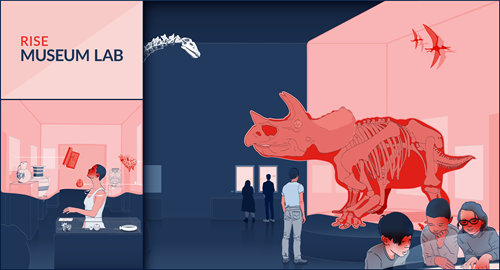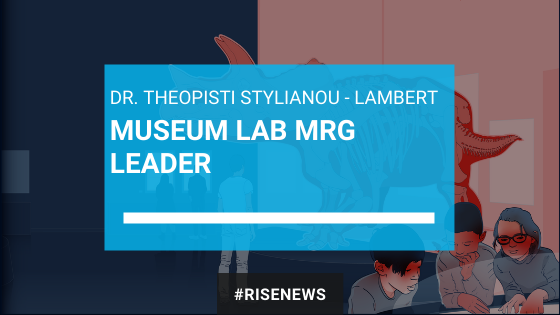Dr. Theopisti Stylianou-Lambert is associate professor at the Department of Multimedia and Graphic Arts at the Cyprus University of Technology and the founder and coordinator of its Visual Sociology and Museum Studies Lab.
Her research interests include museum studies and visual sociology with an emphasis on photography. Theopisti has published widely on museums and photography, is the co-author of The Political Museum (Routledge, 2016) and the editor of Museums and Visitor Photography (MuseumsEtc, 2016), Museums and Photography: Displaying Death (co-editor, Routledge, 2017), Photography and Cyprus: Time, Place, Identity (co-editor, I.B.Tauris, 2014), and Re-envisioning Cyprus (co-editor, University of Nicosia Press, 2010). She received her PhD in Museum Studies from the University of Leicester (UK) and her MA in Visual Arts/ Museum Education from the University of Texas at Austin (USA).
Dr. Theopisti Stylianou-Lambert is also the recipient of several scholarships and awards including a Smithsonian Fellowship in Museum Practice (USA), a Fulbright Fellowship (USA) and an Arts and Humanities Research Council Award (UK).
Dr. Theopisti Stylianou-Lambert is also co-chair to the first RISE IMET International Conference on Emerging Technologies and the Digital Transformation of Museums and Heritage Sites, along with Maria Shehade, which will be held in Nicosia, Cyprus, on June 3-5th 2020. We wanted to share some valuable insight to her work and she was more than kind to be part of our blog.
1. What triggered your interest in investigating the advantages and limitations of emerging technologies for uses in the cultural sector?
I have been studying and working with museums for the last twenty years and during these years we have witnessed significant changes in how technology is used in cultural heritage institutions. Technology has touched all basic functions of a museum: from collecting, documenting, preserving, exhibiting, to educating and promoting. But most importantly, emerging technologies are continuously challenging and expanding basic museum concepts such as the nature of collections, audiences, spaces and, as an effect, the role of museums in society today.
In recent years, a growing emphasis is placed on the possible applications of new technologies in museum environments and on the potential advantages that such applications can have on the overall visitor experience. Although a large corpus of literature has been devoted to the advantages of technology for museum visitors, the actual evaluation of the effects of these technologies or their possible limitations remain an under-studied area. Most of the current literature explores the technical aspect of technological applications and the difficulties that may be encountered in the development of such projects.
Obviously, it’s not constructive if technology is used for the sake of it or for the sake of innovation but it should be designed with the visitor in mind. Thus, the need to adopt a ‘user-centric’ approach, while keeping in mind the challenges of technology in museums, when developing new technologies for museum spaces is imperative. At the Museum Lab we believe that technological applications should be flexible, seamless, immersive, user-centric, and should promote social engagement, and critical thinking. Moreover, apart from their use in promoting knowledge or entertainment, new technologies may also be seen as promoting imagination or collaboratively experiences. Finally, emerging technologies can be used to create artworks and that adds complexity on the collection and preservation of artworks that use emerging technologies (see “MuseumArtTech” project).

2. What is the ultimate goal you want to achieve through the Museum Lab MRG?
The Museum Lab MRG is dedicated to the interdisciplinary exploration of emerging technologies inside and outside museums, galleries and other heritage sites. As mentioned above, one of the goals of the Museum Lab is to investigate the advantages and limitations of immersive technologies for uses in the cultural sector. Only this way we can envision a more appropriate and user-centered design and uses for emerging technologies. Furthermore, the Museum Lab MRG aims to explore how technology can help expose different layers of history in places of contested heritage and help visitors/users negotiate difficult or awkward heritage (see for example the “Ledra Palace Museum” project). Difficult heritage consists of elements of a past that are considered important but can also be contested and awkward. Representing difficult heritage in and outside museums is a timely challenge many museums face today, especially in countries dealing with social or political conflict such as Cyprus.
3. Tell us about the RISE IMET 2020 conference?
One of the aims of the Museum Lab is to create an interdisciplinary community of researchers and practitioners who are interested in innovative uses of technology in museums and other heritage sites. For this reason we are working on an edited volume with the title “Museum Media(ting): Emerging Technologies and Difficult Heritage” (see http://www.rise.org.cy/en-gb/research/research-groups/museum-lab/news/museum-media(ting)-emerging-technologies-and-diff/) and an international conference – the first organized by RISE – with the title “Emerging Technologies and the Digital Transformation of Museums” (RISE IMET 2020) (see https://cyprusconferences.org/riseimet2020/). We hope that the conference will attract academics and professionals from the fields of museum studies, cultural heritage, computer science, heritage management, artificial intelligence, visual arts and cognitive science amongst others.

M. Shehade and T. Stylianou-Lambert, “The Future of Technology in Museums,” in The Future of Tradition in Museology, Materials for a discussion, Japan, 2019.
DOI: https://doi.org/10.5281/zenodo.3524099
Repository link: https://zenodo.org/record/3524099#.Xbrb8JozaUk
This paper was presented in ICOM Kyoto 2019 (https://icom-kyoto-2019.org/)

